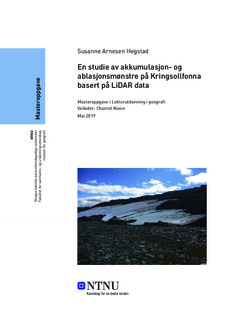| dc.description.abstract | Denne oppgaven analyserer og tolker massebalansen til en permanent snøfonn i Sør-Norge, Kringsollfonna, i perioden 2015 til 2018. Kringsollfonna er lokalisert på Dovrefjell i Trøndelag, på den nordøstlige siden av fjellet Kringsollen cirka 1500 moh. Dens areal er omkring 0,046 km2 under den studerte perioden. Alderen til denne snøfonnen er til estimert 5000 år, noe som indikerer en motstandsdyktighet til tidligere, mindre, klimaendringer. Feltarbeidet for denne oppgaven ble gjennomført i september 2018. Ved bruk av Light Detection And Ranging (LiDAR) skanning, ble det samlet inn massebalansedata for snøfonna. I tillegg så ble allerede eksisterende data, fra LiDAR skanninger for årene 2015 og 2016, sammenliknet med de innsamlede dataene.
Massebalanse fra ulike år mellom 2015 og 2018 ble analysert i periodene fra 2015 til 2016, 2015 til 2018 og 2016 til 2018. Resultatene viste en negativ massebalanse fra 2015 til 2016 og for hele den studerte perioden fra 2015 til 2018, mens en positiv massebalanse ble kalkulert for perioden 2016 til 2018. Fra detaljerte overflatemodeller av snøfonnen, skapt fra LiDAR punktskyer, var det mulig å oppdage områder av snøakkumulasjon og ablasjon i de ulike periodene.
Tilslutt, ble de ulike periodenes massebalanse sammenliknet med klimatiske faktorer som vind, temperatur og nedbør for de spesifikke årene, og deres påvirkning på massebalansen ble diskutert. Resultatene av denne analysen viser at den permanente snøfonnen ser ut til å stå imot mindre endringer i klima, på grunn av selvregulerende feedbackmekanismer som forekommer under vintersnøakkumulasjon. | |
| dc.description.abstract | This thesis analyzes and interprets the mass balance of a permanent snow patch in Southern Norway, named Kringsollfonna, for the period between 2015 and 2018. It is located in the Dovre mountains in Trøndelag province, at the northeast flank of the mountain Kringsollen at ca. 1500 m.a.s.l. Its area is roughly 0.046 km2 during the studied period. The estimated age of this snow patch is 5000 years, indicating a resilience to past smaller climate changes. For this thesis, fieldwork was carried out during September 2018 to acquire mass balance data, using Light Detection And Ranging scanning. Additionally, already existing mass balance data from LiDAR scans of the years 2015 and 2016 are compared to the collected data.
Mass balances from different years between 2015 to 2018, were analyzed in steps from 2015 to 2016, from 2015 to 2018 and 2016 to 2018. Results showed a negative mass balance from 2015 to 2016 and for the entire studied period from 2015 to 2018, whereas a positive mass balance was calculated for the time step from 2016 to 2018. From detailed demographic elevation models of the snow patch created through Lidar point clouds it was possible to specifically detect areas of snow accumulation and ablation in between the years.
Finally, the different mass balances are compared to climatic factors such as wind, temperature and precipitation for the specific the years and their influence on the mass balance is discussed. Results of this analysis show that the permanent snow patch seems to be mostly resilient to smaller changes in climate due to self-regulating processes that take place during winter snow accumulation. | |
